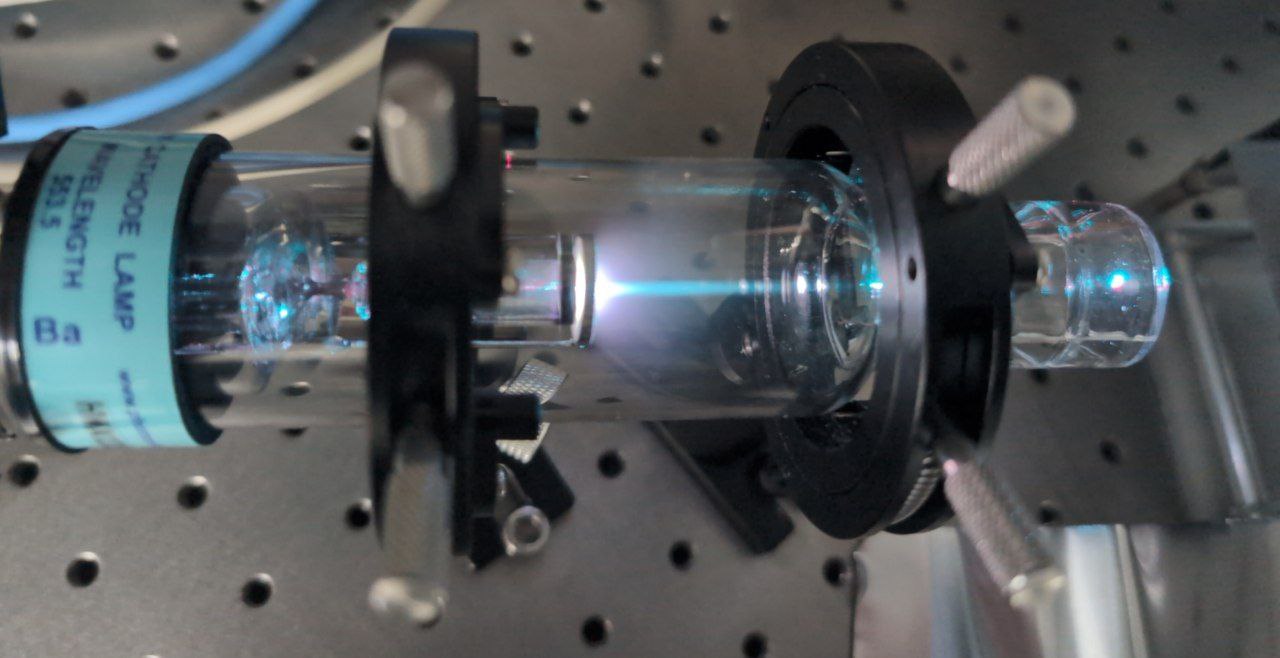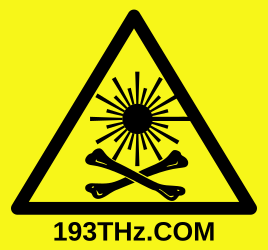

June 2025
A very interesting observation from the previous experiment that drives the 493nm and 650nm Ba+ transitions in a hollow cathode lamp, is that when the lasers are on resonance, the path of the laser beams becomes visible inside the lamp from the ion fluorescence.
Evidently, the plasma discharge emits barium ions that float around over a considerable distance in the front part of the lamp, and the resonant lasers light them up. This is much more than a pretty mini-laser show (the picture does not really do it justice) and an instant visual confirmation that the lasers are on-resonance, as will be explained below.
The most remarkable effect, physics-wise, is that while keeping the 493nm laser on-resonance and sweeping the optical frequency of 650nm laser, the length of the 493nm (cyan) fluorescence column is extended when the 650nm laser hits resonance. This is because in the front part of the lamp, the ions are not constantly repumped by the electrical discharge, and when pumped by the 493nm laser they eventually get stuck in the long-lived D3/2 state (branching ratio is around 1/4) and stop absorbing the 493nm light. And, just like in a fancy ion trap, the 650nm laser repumps them and allows the 493nm cycle to continue. It may sound surprising that this can be observed so easily in such a simple and cheap system with crudely tuned lasers, but considering that with an estimated buffer gas pressure of 1 mbar (corresponding to a mean free path of 100 microns) there is plenty of opportunity for low-energy collisions that do not change the ion's state but change its thermal velocity and allow Doppler broadening (and absorption of light from roughly-tuned lasers) to continue.
Besides the cool physics demonstration, there is an immediate application of this effect: telling apart the 649.6898nm transition of Ba+ from the 649.8760nm transition of neutral Ba. Both are visible in the optogalvanic signal, and push the accuracy limit of cheap optical spectrometers. You can use the direction of the laser's temperature change (cooler means shorter wavelength) when scanning as an aid to tell those two lines apart, but it is hard to ascertain that the laser didn't mode-hop in-between, so this is not foolproof. But using this $0 eyeball trick, the guesswork is completely eliminated: when the laser is correctly tuned to the Ba+ transition, the cyan tail of the fluorescence column is extended, whereas it stays the same length when the laser is incorrectly tuned to the neutral barium transition.
Secondly, the fluorescence can be electronically detected and used as a spectroscopy and laser locking signal in lieu of the optogalvanic effect. The challenge here is that the light is emitted in all directions and over a large area; the way to deal with this in a simple and cheap manner is to use a solar cell. I have used a "44X24" "5V 30mA" solar cell from Aliexpress connected between emitter and base of a BD243C NPN transistor. The low impedance of this junction allows the bandwidth of the circuit to reach into the dozen kHz region despite the high capacitance of the solar cell. The background light from the plasma discharge is enough for the solar cell to produce more than the 0.7V forward voltage of the base-emitter junction, and further biasing is not necessary. Then the collector-emitter junction is connected to the XLR input of the Behringer UMC202HD with phantom power turned on. See this photo of the assembly. The BD243C transistor is oversized for this job, but that's what I had at hand which would accept the relatively high phantom power voltage (48V). The solar cell is then simply placed on top of the hollow cathode lamp, and a quick test with Soundlocker showed promising results in terms of signal to noise ratio.
A similar idea can be found in Building Electro-Optical Systems, section 3.10.11 "Use Solar Cells at AC", with a much more sophisticated (and no doubt better-performing) circuit where the bipolar junction transistor is used as a common-base input stage to a transimpedance amplifier, forming a peculiar kind of cascode circuit. It would also be a good idea to drive the soundcard's XLR input in a differential manner instead of driving only one signal of the pair as this hack does. But all these solutions take much more than just one cheap transistor ;)
Lastly, using the atoms and ions emitted in front of the plasma discharge may make it possible to perform Doppler-free spectroscopy with the laser beams going through the sides of the lamp, perhaps using corrective optics to solve problems caused by the glass curvature. The point of doing it this way is to avoid overpriced see-through hollow cathode lamps. So far I have not explored this idea.